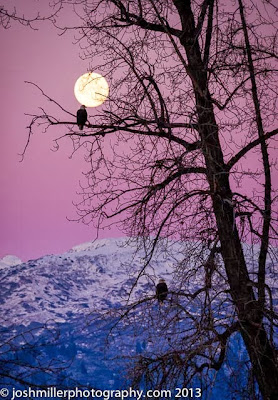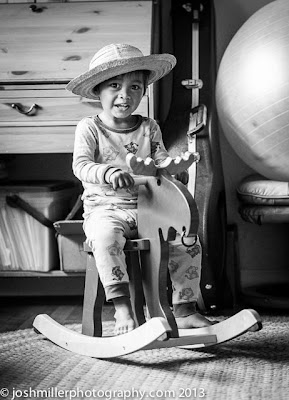Jen and I
just spent a great three nights at the Ostrander Hut, 10 miles into the
Yosemite backcountry. The hut has long been considered the premier ski hut of the
Sierra and a must do trip for any serious outdoor adventurer. So how could
we resist? Funny how things happen, because though the trip started out as an adventure for us and one other couple, it turned into a trip of 15 people! We all met in Yosemite Valley the night before at the campground, and talked over meals and ski plans. Then the next morning we drove up to Badger Pass where we finished packing and left our cars near the trailhead.

The first five miles of skiing went amazingly quickly on the groomed, but crusty, Glacier Point Road. We stopped at the start of Horizon Ridge to eat lunch and treat some blisters. Then it was another five miles of up and down (mostly up), but with the poor snow pack this year, several times we found ourselves skinning across pine needles rather than snow. By the time we made it to the hut, most people in our group were pretty worked, and several showed up right as it got dark.

With the hard part behind us though, we quickly forgot the struggle of getting to the hut and set about making the trip as enjoyable as possible . . . which of course involved a nice warm fire and a glass of wine. When we woke in the morning we found that the foot of fresh powder predicted hadn't arrived and that the storm was only just beginning. So after a leisurely breakfast that turned into lunch, we eventually put on our storm gear and headed out for an adventure.
We discovered that Fritz, the hut keeper, had been right when he said that despite only having a few inches around the hut, the North Facing slopes on the ridge were great skiing. With hoods fully zipped against blowing snow, we made two climbs and had a great afternoon playing in the first new snow in more than a month.
 With everyone rested, warm, and happy, that night turned out to be party night. Once I found out that Fritz and Lindsey, his wife, had a guitar stashed away in the root cellar, I couldn't help busting out a few tunes with backup from a wash basin standup base (redneck style for sure). Yes, that is me on the guitar.
With everyone rested, warm, and happy, that night turned out to be party night. Once I found out that Fritz and Lindsey, his wife, had a guitar stashed away in the root cellar, I couldn't help busting out a few tunes with backup from a wash basin standup base (redneck style for sure). Yes, that is me on the guitar.
The following day was what makes living in the Sierra worth all the hassles of crowded California. Fresh untracked powder, bluebird skies, views down to Half Dome, and only our friends to share it with. While some people skied the steeps, the rest of us went exploring along horizon ridge and found some amazing tree skiing along with some of the best views of the Yosemite high country I have ever seen. Obviously many photos were taken and many high-fives were given. After skiing, there was nothing better than to spend the afternoon with a cup of hot soup on the porch of the hut enjoying the view and the warmth of the sun.


So after three nights and amazing ski conditions, my only regret from our trip was that we hadn't stayed longer. We made great time skiing fresh powder on the way back to Glacier Point Road with only a short section of carrying our skis to avoid the rocks and dirt. Even the one member of our group who hiked out all 10 miles carrying his broken skis on his pack said it was the trip of a lifetime.
For those photographers out there, in order to save weight I carried my Olympus EM-5 Micro 4/3 system rather than my heavier Nikon full frame system. For 90% of everything I shot, it performed amazingly well and I never missed my heavier gear. But for the action sequences I did end up missing a lot of shots because of its poor continuous-auto focus. I love the system for static subjects or street photography, but for action or high level landscape work, I'll continue to take my Nikon gear in the future. If I did the trip again tomorrow, without a doubt I would still take the micro 4/3 gear again, because I wasn't there to shoot action, but rather to enjoy the trip.
Sunset on Half Dome
Equipment
Olympus EM-5
Really Right Stuff grip (makes the camera so much more functional)
Mini flash that comes with the EM-5
2 Olympus batteries
2 knock off batteries, which suck!
Lenses
Don't forget, micro 4/3 is a 2x crop system so the focal length is equivalent to double on a full frame camera.
Olympus 9-18mm f/4-5.6
Panasonic 20mm f/1.7 for low light interior work
Panasonic 45-200 f/4-5.6
 The other day I had the chance to photograph the first winter storm as it left a fresh blanket of snow on the historic gold rush town of Nevada City California. It doesn't hurt that I live only about 15min from downtown. It is rare that it storms on a Friday night, but clears on Saturday morning. This allows for some great photography while the town is nearly empty of people. About the only people around town at 7am on a snow Saturday morning were a few other photographers who were all very kind not to track the fresh powder.
The other day I had the chance to photograph the first winter storm as it left a fresh blanket of snow on the historic gold rush town of Nevada City California. It doesn't hurt that I live only about 15min from downtown. It is rare that it storms on a Friday night, but clears on Saturday morning. This allows for some great photography while the town is nearly empty of people. About the only people around town at 7am on a snow Saturday morning were a few other photographers who were all very kind not to track the fresh powder.
















































